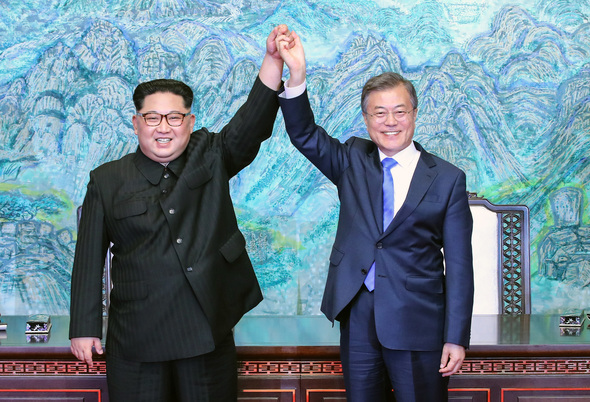Posted on : Jun.27,2018 16:04 KST
Modified on : Jun.27,2018 16:24 KST
 |
|
South Korean President Moon Jae-in North Korean leader and Kim Jong-un hold hands after signing the Panmunjeom Declaration during the Apr. 27 Inter-Korean Summit.
|
The South Korean government is reportedly considering the option of suspending independent live-fire artillery drills that the military holds every year on islands near the Northern Limit Line in the Yellow Sea. The live-fire exercises on these northwestern islands, which have involved weaponry including the K-9 Thunder, a self-propelled howitzer, are a risk factor for inter-Korean military clashes, since North Korea is always touchy about them. These exercises were the excuse that North Korea gave for its bombardment of Yeonpyeong Island in Nov. 2010.
South Korea and the US have already suspended their joint Freedom Guardian exercises and the Korea Marine Exercise Program – if South Korea continues by suspending its independent exercises as well, this will clearly go a long way to expanding the mood for dialogue on the Korean Peninsula and mitigating military tensions. South Korea, North Korea and the US need to keep cooperating to extend these trends.
In connection with this, it is worth noting the remarks made by Prime Minister Lee Nak-yeon during a service marking the anniversary of the Korean War on June 25: Lee said that a discussion was underway about North Korea relocating its long-range artillery away from the front. When Lee’s remarks created an uproar, the Office of the Prime Minister tried to take them back, explaining that Lee did not mean that this issue was being discussed with North Korea but was rather being considered inside the South Korean government.
There had also been speculation that a discussion of moving the long-range artillery had begun during the 8th round of general-level inter-Korean military talks on June 14, but this was denied by the Defense Ministry. Even so, the Office of the Prime Minister’s explanation can be said to clarify that the South Korean government intends to add the issue of pulling back the long-range artillery to its agenda in talks with the North.
The long-range artillery that North Korea has concentrated on the front lines near the military demarcation line is a key conventional weapon system, and indeed the greatest threat after its nuclear arsenal. Around 1,000 artillery pieces are deployed around the military demarcation line, of which over 330 are thought to be aimed at the Seoul area. It goes without saying that relocating these pieces to the rear would definitely ease military tensions around the armistice line. But since North Korea has agreed to give up its nuclear weapons, it does not seem likely that it would give ground on its long-range artillery as well. For South Korea to convince the North to pull back its long-range artillery, therefore, it must walk a mile in its neighbor’s shoes and take corresponding measures to reduce the North’s security concerns.
In the Apr. 27 Panmunjeom Declaration, the leaders of South and North Korea agreed to “make joint efforts to alleviate the acute military tension and practically eliminate the danger of war on the Korean Peninsula.”
To implement that agreement, the two sides have ended propaganda broadcasts on loudspeakers located at the military demarcation line and have held military talks. But that’s just the beginning. If North Korea dares to pull back its long-range artillery separately from the process of denuclearization, that would go a long way toward bringing peace to the Korean Peninsula. We look forward to the North making that bold decision.
Please direct comments or questions to [english@hani.co.kr]






